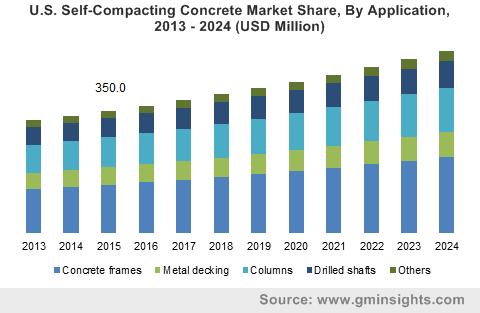Self-compacting concrete market to amass remarkable gains from construction sector, APAC to drive the regional landscape
Publisher : Fractovia | Published Date : 2017-11-21Request Sample
One of the most remunerative, renowned, and rapidly evolving business spheres of recent times, self-compacting concrete market has been phenomenally influenced by the changing trends of construction industry. Self-compacting concrete, of late, has become an integral component of modern construction activities owing to some of its excellent beneficiary features like high flowability and segregation resistance. In response to the extensive use of this material in the evolving constriction sector, self-compacting concrete industry size is anticipated to witness a massive proliferation in the forthcoming years. Statistics further can be placed as an affirmation to the aforementioned declaration- the overall construction spending in the year 2015, was almost around USD 7 trillion, and is slated to exceed USD 13 trillion by the end of 2023.
U.S. self-compacting concrete market size, by application, 2013 - 2024 (USD Million)

A large number of macro-economic factors which are closely linked with construction domain, needless to say, has left a perpetual influence on the self-compacting concrete market dynamics. For instance, the demographic structure across GCC countries had wide range implications on the construction sector, which by extension has soared up the demand for self-consolidating concrete. Reports claim, the GCC belt has been one of those few regions which have observed a tremendous economic boost post the financial crisis in 2008, with a record of GDP growth of almost 24% over the period of 2008-2013. As per a report brought forth by the Centre for Economic and Business Research, within the span of half a decade (2008-2013), the population of GCC countries had risen by almost 20%, which is claimed to be six times faster than the growth rate that was observed in U.S. and U.K. The meteoric rise of self-compacting concrete industry demand across this belt is thus quite vividly coherent, given the extensive proliferation of construction activities in response to the thriving population growth.
Self-compacting concrete Industry has indeed brought a revolution in the construction sector, inherently fueled by its ability to achieve full consolidation without any kind of mechanical vibration and compromise on consistency of quality. With the deployment of SCC getting more pronounced in constructional projects, the requirement of R&D activities to exploit its full potential has become even more crucial. In fact, recently, self-compacting concrete market players are heavily engaging in diversifying the product matrix in sync with the sustainability and environmental viability trends. In this regard, a new concept, so-dubbed as Eco-SSC or Eco-friendly self-compacting concrete, claimed to possess low cement content, is already introduced in Asia and Europe. The fact that Eco-SSC is mainly manufactured by aggregate gradation, makes it the most suitable option for majority of the constructional activities. In tandem, a plethora of governmental standardization, growing consumer consciousness about environmentally viable buildings, and green certification, collectively indicate ‘Eco-SSC’ to be the next disruptive trend that would influence self-compacting concrete market growth.
While a major chunk of the end-use landscape of self-compacting concrete market is procured by construction domain, the business space is also set to reap substantial profits from oil & gas applications. With the product is being extensively deployed for applications like drilling shafts and pipelines to recover oil reserves beneath the ground, the overall market commercialization is anticipated to observe phenomenal gains over the ensuing years. In fact, overall self-compacting concrete industry from drilling shafts alone has surpassed the billion-dollar benchmark, having garnered a revenue of USD 2 billion in 2016. In this regard, it is prudent to mention that drilling activities in U.S. have lately observed a tremendous surge, making the region parallelly lucrative for self-compacting concrete industry. As per estimates put forth by World Oil, drilling activities in the country is expected to rise over 26% in 2017, which would lead to the drilling well count to almost 18,552.
Speaking of geographical penetration, Asia Pacific has been a vanguard of global self-compacting concrete market over the recent years, having held a revenue of USD 14 billion in 2016. Rapid industrialization and urbanization across major economies are claimed to be the prime factors enhancing the regional market outlook. According to the reports, with China at the growth front, APAC belt is expected to account for almost 60% of the overall construction spending by 2025. In addition, numerous favorable policies implemented by the governmental bodies under the structural reform plan will further complement the self-compacting concrete industry growth.
However, high price trends of the raw materials when compared to its conventional counterparts along with limited product utilization in infrastructure sector is hindering the market penetration across some of the geographies. Nonetheless, leading market giants, in a way, are set to exploit the numerous challenges and opportunities of the business space, readily investing in advanced techniques that not only ensure cost-effective solutions but also improved functionality.
Companies engaged in self-compacting concrete market are concentrating on forging strong alliance to come up with innovative sustainable solutions. Citing a latest instance, Tarmac, one of the most acclaimed U.K. based leading sustainable materials group, has recently acquired remaining 50% share of Scottish Power under its long-standing ScotAsh joint venture. Reportedly, through this deal, the U.K. based giant would get the full ownership of ScotAsh. Experts deemed this move to be highly strategic from Tarmac’s perspective, with regards to its aim of expanding its customer base with cutting-edge solutions, leveraging the superfluity of combined expertise of both the organizations. With the world treading on the path of sustainability trends, the room for evolution of self-compacting concrete industry is huge. Global Market Insights, Inc., forecasts the overall self-compacting concrete market size to exceed a valuation of USD 30 billion by 2024.